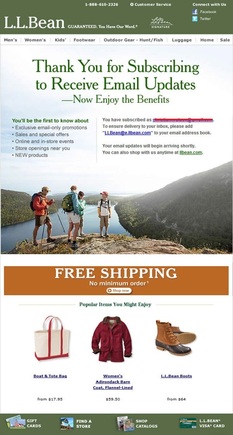Email serves many functions for ecommerce businesses. It’s a method of sending order confirmations and shipping notifications. It also delivers valuable content via newsletters. The goal of each function differs widely, depending on your site and the average sales cycle and order value.
There are many tips and tricks to increase opens, clicks, and conversions. Below are five pointers to generate immediate sales from your email list.
1. Emphasize Segmentation
To maximize the chance of a subscriber opening an email and purchasing immediately, segment your file to make the email relevant and actionable. A logical segmentation strategy is a combination of last purchase and interaction with your email program — i.e., last open or click. Divide your file into (a) frequent purchases, (b) purchased once previously, and (c) those that have never purchased. Your email offer, language, and strategy should differ for these three groups.
2. Focus on the Offer
The offer drives conversions. It should be actionable with a quick deadline, and enticing enough for people to order right then and there — and not come back later. Sending an initial offer announcement with follow-up reminders of the deadline expiring will help. The most aggressive offer and communication should be for the group that has never ordered before.
Frequent purchasers should have an offer that rewards them for their loyalty, and encourages that behavior. Rewards programs can do this. Sending reminders or reward points or balance notifications is an easy way to keep this group engaged and mindful of your company.
Ebates is a good example of a site that rewards frequent purchases with a cash back rewards program. Many shoppers forget to go through the site, so sending frequent reminders to these customers is vital to getting people back to convert.
3. Design for Usability
Ecommerce usability often calls for an easy shopping cart experience with as few steps as possible to finishing a purchase. Think of your email campaigns — and the process of purchasing from an email — in the same manner. The further you can land a customer into the purchasing path, the better your conversion rates will be.
Emails should rarely land customers on your home page. They should go to specific product pages or categories within the email. Adding your navigation bar in the email itself will allow users to apply their first navigation click in the email itself. I’ve analyzed hundreds of email reports to understand where people click on an ecommerce campaign. Many times it is on the navigation bar or other category breakdown element within the email body.
It is important, however, not to get too specific. Feature products in an email to get people interested in the overall selection. That’s because, when featuring a specific product, very few people will click and purchase that particular item. As such, when choosing products to feature in emails make sure they have broad appeal or they are new products that will spark interest.
4. Go for Immediate, Repeat Orders
Frequently the best time to solicit a second purchase is immediately after customers have placed an order. This is because the experience is fresh, and if they were pleased with the overall process and the products they received they could likely purchase again soon.
For example, I recently placed an order from L.L.Bean for a fleece pullover. The process was easy and the product was shipped free. I liked the item so much that within one week I ordered another one in a different color.
To create repeat purchases like these you need to ensure your follow-up email marketing program is optimized. Make sure to include offers or coupons in the body of order confirmation or shipment notification emails. Send a “thank you” email after customers receives their items with a free shipping offer on their next purchase. The point is to bring down any barriers that will prevent people from buying again immediately. Shipping costs are often a reason for not placing another smaller follow-up order. Address this in your follow-up marketing strategy.
This "thank you" email from L.L.Bean includes additional product offers. Enlarge This Image
Enlarge This Image
5. Promote Up-sells and Cross-sells
Generating an immediate purchase is wonderful. But driving up the average order value is even better — especially when an attractive offer may reduce profit margins. Make sure your emails and your ordering processes are optimized for up-sell and cross-sell opportunities. If a customer purchases running shoes, for example, offer running shorts or socks in your shopping cart and in your order confirmation and shipping notification emails.
This order confirmation from Shutterfly includes offers for complementary items. Enlarge This Image
Enlarge This Image




